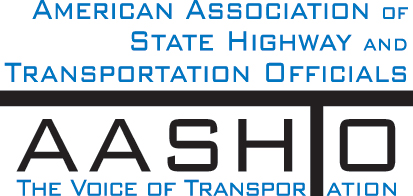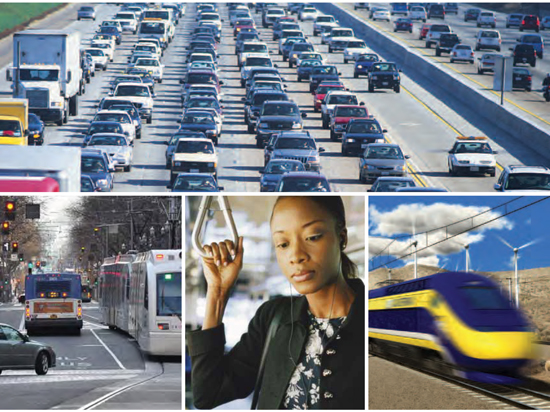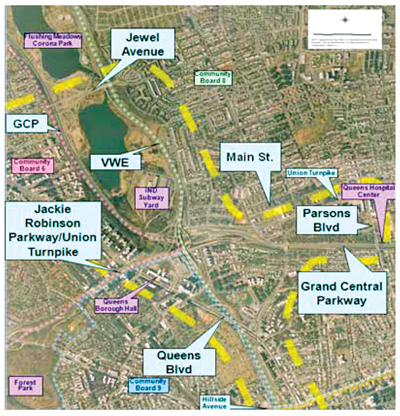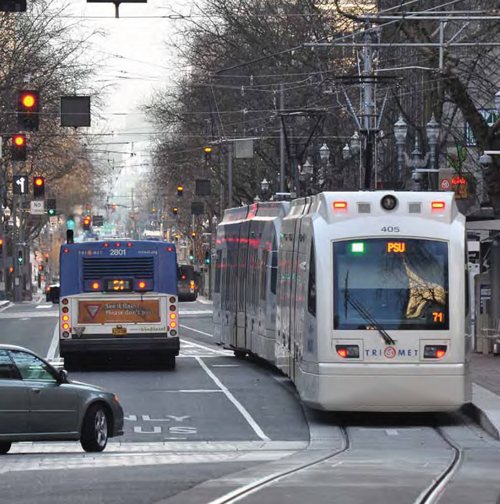|
||||
GROWING FREIGHT DEMANDS REACHING TRANSPORTATION CRISIS, AASHTO STUDY SAYS
We disagree. Does AASHTO support investing more in transit? Absolutely. States today actually invest more in transit than does the federal government. In 2007, states spent $13.3 billion on transit, compared to federal funding of $10.7 billion. AASHTO supports doubling of transit ridership by 2030 and increasing federal transit funding by 89 percent. Does AASHTO support investing more in intercity passenger rail? Of course. State departments of transportation have called for investing $50 billion during the next six years to expand intercity passenger rail service. But transit and intercity passenger rail investments alone cannot begin to meet the nation’s transportation needs. A more balanced approach is needed that recognizes how Americans choose to travel. Today 95 percent of passenger travel in America is made by car, motorcycle and truck, and 93 percent of freight by value moves on our highways. Expanding highway capacity is not the only thing that will be required to meet future mobility needs, but it will be a principal part of what will be required.
In 10 years an additional 1.8 million trucks will be on the road. In 20 years, for every two trucks today, another one will be added. Already, bottlenecks on major highways used by truckers every day are adding millions of dollars to the cost of food, goods, and manufacturing equipment for American consumers. As a result, according to a new report released recently, the transportation system that supports the movement of freight across America is facing a crisis. At recent joint news conferences in Des Moines, Iowa; Memphis, Tennessee; and Harrisburg, Pennsylvania, the American Association of State Highway and Transportation Officials (AASHTO) released Unlocking Freight, an analysis of America’s freight system that finds our highways, railroads, ports, waterways, and airports require investments well beyond current levels to maintain – much less improve – their performance. The report identifies key projects in 30 states that would improve freight delivery and dependability, and offers a three point plan to address what is needed to relieve freight congestion, generate jobs and improve productivity. AASHTO President and Mississippi DOT Executive Director Larry L. “Butch” Brown said, “The simple fact is: no transportation, no economy. They are inseparable. We must invest to maintain and strengthen the American ‘transconomy.’” At the Annual Meeting of the Mississippi Valley Conference of State Highway and Transportation Officials (MVC) in Des Moines, Brown said, “Congress must invest in all transportation modes from waterways to roads and rails to get us where we need to be as a competitive nation. Millions of jobs and our nation’s long term economic health depend on it.” Despite more long distance freight being moved by intermodal rail, the report finds that trucks will still carry 74 percent of the load. On average, 10,500 trucks a day travel some segments of the Interstate Highway System today. By 2035, this will increase to 22,700 commercial trucks for these portions of the Interstate with the most heavily used segments seeing upwards of 50,000 trucks a day. Yet, between 1980 and 2006, traffic on the Interstate Highway System increased by 150 percent while Interstate capacity increased by only 15 percent. The report identifies the 1,000 miles of most heavily traveled highways used by trucks. In a related news conference releasing the report in Pennsylvania, Governor Edward Rendell stood at the Norfolk Southern Intermodal Facility in Harrisburg and said, “This report outlines what’s at stake if we fail to invest to meet the growing demands on our transportation infrastructure. This includes the roads, rails, and seaports we need to move raw materials and goods to market and keep our economy globally competitive.” “As the gateway to the Northeast, Pennsylvania gets more than our share of truck traffic,” Rendell said. “In fact, Pennsylvania is one of six states, along with Arkansas, California, Georgia, Tennessee and Texas that collectively account for 88 percent of the most heavily used truck routes.” “It’s unfortunate that many of the 35 million travelers who hit the road for the Fourth of July holiday this past weekend spent hours of their vacation time stuck in traffic,” said John Horsley AASHTO’s executive director. “Ten thousand commercial trucks face that kind of gridlock everyday.” MVC President and Iowa Department of Transportation Director Nancy Richardson said at the Iowa news conference that her state’s agricultural and manufacturing supply chain is crucial to the economic recovery, stability, and growth of Iowa and the nation. States “need greater investment and sound federal transportation polices to allow them to expand capacity when and where necessary.” MVC Vice President and Minnesota DOT Commissioner Thomas Sorel said, “The Port of Duluth-Superior is an example of hundreds of freight related projects in desperate need of greater investment. It’s one of the largest inland seaports in the world bringing in iron ore and coal docks, grain elevators and specialized cargo facilities lining the industrial waterfronts of Duluth, Minnesota and Superior, Wisconsin. Yet, the infrastructure is currently deficient in terms of capacity, physical condition, and safety.” “The nation's multimodal freight transportation system directly affects economic development, current and future jobs, and the quality of life in our communities,” said Ohio DOT Director Jolene M. Molitoris, MVC incoming vice president. “Today the nation's freight transportation system supports more than 10 million jobs from couriers, truckers, laborers, shippers, railroad conductors and mechanics to postal carriers, warehouse operators and stock clerks. Now, think about how many more jobs will be added as the industry grows over time and you begin to see yet another reason why this study is so important.” In Memphis, Tennessee Department of Transportation Commissioner Gerald Nicely hosted a news conference along with Dan Flowers, the head of the Arkansas DOT, and other state and local officials, industry, and businesses. Nicely said, “To accommodate this predicted growth in freight movement we need to think nationally, regionally, and on a multi-modal level. Central to this effort should be the creation of a National Multimodal Freight Plan to ensure that transportation investments are coordinated and made where most needed. By linking trucks, rail, waterway transport, and aviation, freight can be moved more efficiently throughout the nation.” Each year 147 million tons of freight pass through Tennessee by way of trucks, rail cars and barges. Nearly half of Tennessee’s Gross Domestic Product comes from the movement of goods and more than half of the statewide employment is in goods dependent industries. The segment of I-40 through Tennessee and Arkansas alone accounts for nearly one-third of the nation’s busiest truck miles. A current strain on the movement of freight in the Tri-State region is the lack of vehicular and rail crossings along the Mississippi River according to Nicely. Tennessee, Mississippi and Arkansas are currently working to develop a third Mississippi River bridge crossing dubbed the Southern Gateway Project. Environmental studies on the project are now underway and include consideration of a multi-use bridge that would include both vehicle and rail access.
Census estimates released in 2009 show that population between 2000–2009 grew in every state. California remained the most populous state, with about 36.9 million people. Rounding out the top five states were Texas (24.8 million), New York (19.5 million), Florida (18.5 million) and Illinois (12.9 million). Five states (North Dakota, West Virginia, Louisiana, Rhode Island, and Michigan) grew by less than one percent. The state census projections released in 2009 show the dramatic growth experienced primarily in the South and West in the past decade.
Accommodating metropolitan travel growth will be a challenge not just for local governments, but for the state departments of transportation who oversee urban Interstates that bear the brunt of metropolitan traffic. The solution lies in a combination of increasing highway, transit and passenger rail capacity, along with travel demand strategies.
In 1990 there were 43 urban areas, defined by the Census Bureau as Metropolitan Statistical Areas (MSA’s), with populations of one million and above. By 2009, the number of urban areas with regional populations of one million and above had increased to 52. Just as Census estimates show dramatic growth in southern and western States, Census estimates show urban areas in the South and West also experienced the most dramatic growth. Of the 20 fastest growing MSAs from 2000 to 2009, four are in North and South Carolina, three in Texas, two each in Utah, Florida, Georgia, Arizona and Idaho, and one each in Colorado, Oregon and Arkansas. These 20 cities are all sizes, ranging from the smallest (and fastest growing), Palm Coast, FL expected to nearly double in size adding over 40,000, to the largest, Atlanta, adding 1.2 million or nearly 30 percent of its current population. All told, the 20 fastest growing urban areas will expand by 28 to 80 percent, adding a total of 5,000,000 people. 20 Fastest Growing Metropolitian Areas 2000-2009 Represents urban population growth of 5,301,772
Urban Areas Merge into Megaregions As urban areas grow and blur they become megalopolises, annexing the surrounding counties and growinginto each other’s boundaries. Already, the Boston to Washington DC “Northeast Megaregion” is home to nearly 49 million. Growth in the West gives us a “Southern California Megaregion” topping 25 million,that runs from San Diego to Las Vegas and back to the Pacific where it nearly joins with the 10 million “Northern California Megaregion” of San Francisco to Sacramento to Fresno. Other megaregions comprise the entire state of Florida, Dallas-Austin-San Antonio, with its 11 million blurring into Houston New Orleans’ 9 million. The “Piedmont Atlantic Megaregion” from Atlanta to Charlotte, North Carolina has a population of 15 million. While these super areas seem to function as individual cities, they have multiple distinct centers and will require the infrastructure and capacity to serve not only each center, but center to center needs. They will require transit and roads that serve not only the original urban area, but the new urban area where housing and shopping and working are all centered in megaregions hundreds of miles across.
Accommodating metropolitan travel growth will be a challenge not just for local governments, but for the state departments of transportation who oversee urban Interstates that bear the brunt of metropolitan traffic. The solution lies in a combination of increasing highway, transit and passenger rail capacity, along with travel demand strategies.
Washington is targeting I-5’s worst chokepoints by building capacity, making highways more efficient with traffic technology,
GREATEST NEEDS – NEW YORK
Kew Gardens Interchange Reconstruction The Kew Gardens Interchange, located in the Queens borough of New York City, is theconfluence of three major limited-access freeways, two major highways, and numerous local streets. The interchange is a critical node on the Van Wyck Expressway (Interstate 678) which serves as the only commercial limited-access link to JFK International Airport, and it is essential for freight movement. Additionally, the interchange serves the Grand Central Parkway, a major commuter route to Nassau and Suffolk counties on Long Island and the primary access route to LaGuardia Airport. The interchange was originally constructed as part of the Grand Central Parkway in the 1930s, at a time before interstate development, modern aviation and a global economy. The interchange’s design has remained largely unchanged since its original construction.
Currently the interchange suffers from severe congestion, high collision rates (among the worst in New York City), and deteriorating infrastructure. Reconstructing the interchange will encompass the rehabilitation and/or replacement of several bridges, the widening of the Van Wyck Expressway, reconfiguring all ramps for safety and congestion reduction, and providing improvements to the Van Wyck Boulevard/Briarwood subway station. Maintenance of adequate traffic flow at all times is a significant project challenge due to the complex urban environment in which the work will occur. This large project, to be constructed in four phases, is estimated to cost nearly $500 million. The Kew Gardens Interchange reconstruction will help reconfigure a key link supporting New York’s and the nation’s economy. More than 5,500 trucks daily pass through this interchange on their way to or from JFK Airport, the nation’s busiest international air-freight gateway (by value) in 2008, facilitating 21% of the value of U.S. international air cargo.
As illustrated by this scene from Portland, a balance of transportation options will be needed to provide urban mobility. The American Association of State Highway and Transportation Officials (AASHTO) is the “Voice of Transportation” representing State Departments of Transportation in all 50 states, the District of Columbia and Puerto Rico. AASHTO is a nonprofit, nonpartisan association serving as a catalyst for excellence in transportation.
© 2013 TLC Magazine Online, Inc. |










